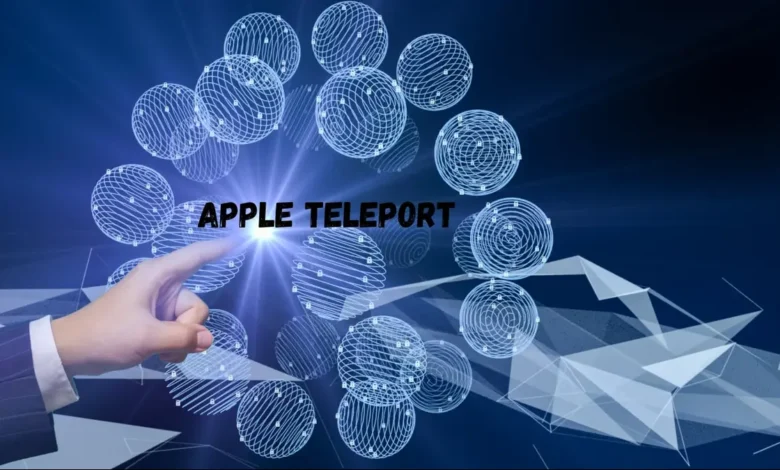A Deep Dive into Apple Teleport: What It Means for the Tech Industry

apple teleportIntroduction to Apple Teleport
Imagine a world where you can step into a pod and instantly appear on the other side of the globe. Sounds like science fiction, right? However, with Apple’s latest innovation—Apple Teleport—this dream might soon become a reality. As technology continues to evolve astonishingly, Apple’s foray into teleportation technology marks a significant leap forward. This groundbreaking development could redefine how we think about travel, communication, and commerce. Curious about what this means for the tech industry and your everyday life? Let’s dive deeper into the fascinating realm of Apple Teleport!
What is Teleportation Technology?
Teleportation technology refers to the theoretical transfer of matter or information from one point to another without traversing the physical space in between. This concept, often associated with science fiction, is gaining traction as scientists explore quantum mechanics and particle physics.
Teleportation involves disassembling an object at a molecular level, transmitting that data elsewhere, and reassembling it perfectly. Imagine sending your favorite apple pie instantly across town!
While still largely experimental, researchers are making strides in quantum teleportation. They’ve successfully transported information about particles over considerable distances, and the implications for communication could be revolutionary.
In essence, this technology challenges our understanding of time and space. It opens up possibilities previously thought impossible—a glimpse into what may become a new frontier in transportation solutions.
The Potential Impact of Apple Teleport on the Tech Industry
Apple Teleport could revolutionize how we view transport and connectivity. By introducing this groundbreaking technology, Apple might reshape not just commuting but also logistics and supply chains.
Imagine instant delivery of products from a warehouse to your doorstep. This shift would enhance efficiency, significantly reducing carbon footprints. The possibilities for businesses are immense, as they can operate more flexibly in reaching customers.
Moreover, the tech industry itself stands on the brink of transformation. Companies will need to adapt their infrastructures and services to accommodate teleportation capabilities. Startups focusing on ancillary technologies may also emerge rapidly.
Consumer behavior is likely to change, too; people may prioritize locations based on teleport access rather than traditional transportation routes. It’s intriguing that our cities could evolve alongside this revolutionary concept.
Advantages and Disadvantages of Teleportation Technology
Teleportation technology promises a new era of travel, offering remarkable advantages. Imagine instant transportation from one location to another. This could save countless hours spent in traffic or at airports. The environmental impact might also lessen as fewer vehicles fill the roads.
However, there are notable challenges. Safety concerns loom large; what happens during transmission? Potential malfunctions could lead to disastrous outcomes.
Additionally, the social implications raise eyebrows. Would teleportation create economic divides? Those who can afford it may gain an unfair advantage over others.
Security issues are also significant: how do we ensure safe teleportation against potential misuse? As exciting as it sounds, this technology demands careful consideration before becoming mainstream.
The balance between innovation and caution will define its trajectory in our society.
Possible Uses for Apple Teleport in Everyday Life
Imagine commuting to work in seconds instead of hours. Apple Teleport could revolutionize travel, eliminating traffic jams.
Picture using it for quick grocery runs or meeting friends across town without hassle. Just think about the time saved when you can teleport directly from your couch to a café without delays.
Traveling abroad would also change dramatically. You could enjoy breakfast at home and lunch in Paris, all within moments.
Events like concerts or family gatherings could become more accessible. No one would miss out due to distance; everyone could be there instantly.
Education may transform, too. Students might teleport into classrooms anywhere in the world, enhancing learning opportunities without boundaries.
The possibilities are truly endless and exciting!
Competitors in the Market and How They Measure Up
The tech landscape is buzzing with competitors eager to make their mark in teleportation technology. Companies like QuantumJump and TeleLink spearhead this movement, each bringing unique innovations.
QuantumJump focuses on rapid transportation solutions for urban environments. Their emphasis lies in creating efficient pathways that minimize time loss during commutes. Meanwhile, TeleLink aims at long-distance travel, targeting international connections that could redefine how we think about distance.
Apple’s entry into this space introduces a sleek interface and user-friendly design. The narrative around Apple revolves around seamless integration with existing devices, which sets it apart from its rivals’ more utilitarian approaches.
While these companies chase technological advancements, they also grapple with regulatory hurdles and public skepticism. As they navigate these challenges, the race to dominate teleportation technology heats up significantly across different sectors within the industry.
Ethical Considerations Surrounding Teleportation Technology
The advent of teleportation technology raises many ethical questions. As we imagine instant travel, implications for privacy and consent become pressing concerns. Who controls the teleportation process?
Another significant issue is safety. Errors could lead to disastrous outcomes if individuals are misplaced or harmed during transport. Furthermore, hacking into teleportation systems could result in severe security breaches.
This technology may also exacerbate social inequalities. Access might be limited to those who can afford it, creating a divide between socioeconomic classes.
The environmental impact cannot be ignored. While traditional transportation contributes to carbon footprints, how does teleportation fare in terms of energy consumption and sustainability?
These considerations urge us to think critically about the future trajectory of such groundbreaking advancements and their broader effects on society as a whole.
Conclusion: Is Apple Teleport the Future of Transportation?
As we look ahead, the launch of Apple Teleport certainly sparks excitement and curiosity within the tech community. Teleportation technology has immense potential to revolutionize transportation, positioning it as a game-changer in how we move from place to place.
However, innovation comes with challenges. As we’ve seen with other technological advancements, ethical considerations must be addressed—privacy concerns and safety regulations among them. Moreover, understanding how this technology can coexist with existing forms of transport will be crucial.
The race to harness teleportation capabilities isn’t just about which company leads; it’s about ensuring sustainability and accessibility for everyone. Whether or not Apple Teleport becomes a staple in our daily lives remains to be seen. Still, one thing is clear: the future holds fascinating possibilities that could redefine our perception of distance and connectivity.
Apple’s entry into this arena may very well set new standards for what’s possible in transportation technologies in the future. With ongoing developments and discussions around its implications, it’s an exciting time to stay informed about what lies ahead.





